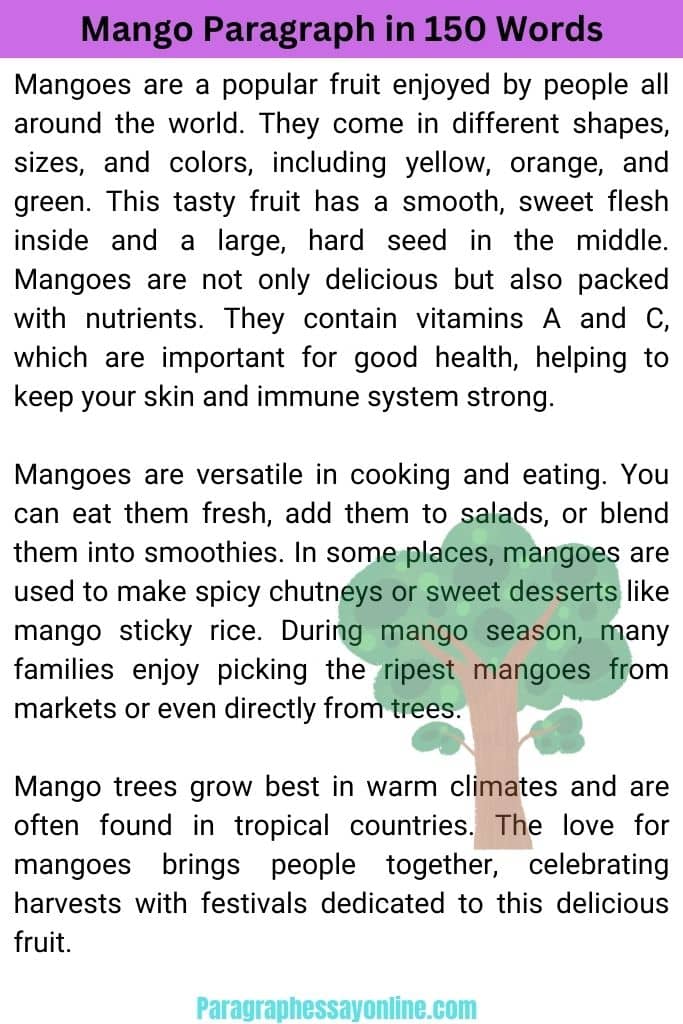Mango Paragraph
Mango Paragraph Long and Short (100-500 words)
Mangoes, the luscious and aromatic fruits, are beloved worldwide for their delectable taste and numerous health benefits. As the national fruit of several countries, mangoes hold a special place in various cultures, featuring prominently in cuisines, festivals, and folklore. Their versatility makes them a cherished ingredient in both sweet and savory dishes.
Paragraph On Mango 100 Words For 1, 2, 3 Students
Mangoes are a special kind of fruit that many people love. They are juicy, sweet, and full of flavor. Mangoes are usually yellow, orange, or green on the outside. Inside, they have a big seed. People in many countries grow mangoes, and they are eaten in many ways.
You can eat them fresh, make juice, or even use them in desserts. Mangoes are also very healthy. They have vitamins that are good for your body. When you eat a ripe mango, it can feel like a treat because it’s so delicious. Kids and adults alike enjoy this wonderful fruit a lot!

Mango Paragraph in 150 Words For 4 & 5 Students
Mangoes are a popular fruit enjoyed by people all around the world. They come in different shapes, sizes, and colors, including yellow, orange, and green. This tasty fruit has a smooth, sweet flesh inside and a large, hard seed in the middle. Mangoes are not only delicious but also packed with nutrients. They contain vitamins A and C, which are important for good health, helping to keep your skin and immune system strong.
Mangoes are versatile in cooking and eating. You can eat them fresh, add them to salads, or blend them into smoothies. In some places, mangoes are used to make spicy chutneys or sweet desserts like mango sticky rice. During mango season, many families enjoy picking the ripest mangoes from markets or even directly from trees.
Mango trees grow best in warm climates and are often found in tropical countries. The love for mangoes brings people together, celebrating harvests with festivals dedicated to this delicious fruit.

Paragraph On Mango in 200 Words For 6, 7, and 8 Students
Mangoes are a delightful fruit loved by many around the globe. They belong to the family of drupes, fruits with a large seed encased by juicy pulp. Depending on the variety, their skin can be a mix of reds, yellows, and greens, while their flesh ranges from pale yellow to deep orange. Mangoes are not just famous for their luscious taste but are also rich in nutrients. They are an excellent source of vitamins A and C, which are essential for immune health and good vision.
Culturally, mangoes hold significant value in many tropical countries where they are grown, such as India, Thailand, and the Philippines. In India, for instance, the arrival of the first mangoes of the season is celebrated with enthusiasm. Mangoes are consumed in various forms – eaten raw, sliced and served with spices, blended into smoothies, or cooked into chutneys and jams. They are also integral to various culinary dishes and desserts like mango lassi and mango sticky rice.
Growing mangoes involves careful tending and warm climates. Mango trees can grow very large and live for many years, bearing fruits annually. These trees bloom with small, fragrant flowers, which then develop into the fruit, making mango season a highly anticipated time of year for many.
Mango Paragraph in 250 Words For 8,9,10 Students
Mangoes are one of the most beloved fruits globally, known for their irresistible sweetness and juicy texture. They originate from South Asia, where they have been cultivated for thousands of years, and today, they are grown in many tropical and subtropical regions around the world. Mangoes vary greatly in size, color, and flavor depending on the variety, which includes types like Alphonso, Kent, and Haden.
This fruit is not only delicious but also packed with nutritional benefits. Mangoes are a great source of dietary fiber, which aids digestion, and antioxidants, which protect the body from free radicals. They are rich in vitamin C, which supports the immune system, and vitamin A, which is crucial for eye health.
In many cultures, mangoes are more than just a food item; they are a part of social and cultural rituals. In countries like India, mangoes are often involved in religious ceremonies and festive celebrations. Moreover, they have a strong presence in the culinary world. They can be eaten raw, dried, or incorporated into various dishes, from chutneys and pickles to smoothies and desserts.
The mango tree itself is also notable. It can reach heights of over 100 feet and live for over a century, continually producing fruit each season. The trees bloom with dense clusters of small pinkish-white flowers, leading to the development of mango fruits, which take several months to mature. The annual mango season is a time of joy and abundance in many regions, celebrated with mango festivals and special events.
Paragraph On Mango 300 Words For 9, 10, 11, 12 Students
Mangoes, known scientifically as Mangifera indica, are one of the most cherished fruits in the world. Originating from South Asia over 4,000 years ago, these fruits are now cultivated in many tropical and subtropical areas across the globe. There are hundreds of varieties of mangoes, each with unique characteristics like size, color, and taste. The Alphonso, known for its rich flavor, is considered one of the finest varieties and is highly prized, especially in India.
Nutritionally, mangoes are a powerhouse, offering an array of health benefits. They are an excellent source of vitamins A and C, both essential for maintaining healthy skin, vision, and immune functions. Mangoes also contain folate, B vitamins, and essential minerals like potassium, which helps regulate blood pressure and fluid balance. The fruit is rich in polyphenols, which have antioxidant properties that help protect against oxidative stress and inflammation.
Mangoes hold a significant place in many cultures, particularly in India, where they are revered not only for their taste but also for their auspicious significance in various rituals and ceremonies. They are versatile in culinary uses, appearing in everything from salads and salsas to curries and desserts. Mango pulp is also used in beverages, such as smoothies and juices.
The cultivation of mangoes is a labor-intensive process that requires specific climatic conditions, mainly warm and dry weather. Mango trees are large and robust, capable of bearing fruit for up to 300 years under optimal conditions. The process from pollination to fruit maturation is complex and influenced by environmental factors, which can affect the fruit’s quality and yield.
The annual mango season is eagerly awaited in many countries, celebrated with festivals and culinary events that highlight the fruit’s cultural importance and delicious flavor. This season not only brings a bounty of fresh mangoes to enjoy but also symbolizes a period of prosperity and happiness in many communities around the world.
Mango Paragraph in 500 Words For 9, 10, 11, and 12 Students
Mangoes, often called the “king of fruits,” are celebrated worldwide for their delicious taste and nutritional value. Originating from the Indian subcontinent, mangoes have been cultivated for over 4,000 years and are now grown in tropical and subtropical regions across the globe, including South and Southeast Asia, South America, and Africa.
This beloved fruit comes in various shapes, sizes, and colors, ranging from green to yellow, orange, and even red. There are hundreds of mango varieties, each with its unique flavor and texture. Some of the most popular types include the sweet and creamy Alphonso from India, the large and mildly sweet Kent from Mexico, and the fibrous and juicy Tommy Atkins from the United States.
Mangoes are not only prized for their luscious taste but also for their impressive health benefits. They are a rich source of vitamins A and C, which are crucial for immune function, skin health, and vision. Mangoes also provide a good amount of dietary fiber, promoting digestive health, and contain various antioxidants and enzymes that aid in digestion and help fight inflammation.
The cultural significance of mangoes extends beyond their culinary uses. In many countries, especially in India, the mango is deeply embedded in the culture and traditions. It is often used in religious rituals and ceremonies and is a symbol of love and fertility. The arrival of the mango season is celebrated with great enthusiasm, with festivals and markets dedicated to showcasing the fruit in all its glory.
Culinary uses of mangoes are diverse and versatile. They can be eaten raw, sliced, and served with a sprinkle of salt and chili powder, or used in a variety of dishes, from chutneys and pickles to salads and desserts. Mango pulp is a key ingredient in smoothies, juices, and ice creams, and its rich flavor complements both sweet and savory dishes.
Mango trees are evergreen, growing up to 100 feet tall, and can bear fruit for decades. The trees produce fragrant flowers which are pollinated by insects and occasionally by wind, leading to the development of fruits that typically mature in three to six months, depending on the variety and environmental conditions.
The process of growing mangoes can be challenging due to pests and diseases like powdery mildew and fruit flies, which require careful management. Farmers often employ various techniques to protect the trees and ensure a good harvest, including pruning, the use of netting to prevent fruit fly attacks, and spraying with fungicides to control fungal diseases.
In terms of global trade, mangoes are a significant commodity. India is the largest producer, followed by China, Thailand, and the Philippines, but much of the mango production is consumed domestically within these countries. The international market for mangoes continues to grow, driven by increasing demand in North America and Europe.
Whether enjoyed fresh from the tree, blended into a smoothie, or incorporated into various culinary creations, mangoes continue to capture the hearts of people around the world, embodying a sense of joy and abundance wherever they are grown.
Most Important Paragraph:
| Favourite Sportsman Paragraph. |
| Waste Management Paragraph. |
| Likes And Dislikes Paragraph. |
| Water Pollution Paragraph. |
| My Pet Animal Paragraph. |
Frequently Asked Questions on Mango Paragraph
Q: How do mangoes grow?
Mangoes grow on mango trees (Mangifera indica) in tropical and subtropical regions. They require a warm climate, adequate rainfall, and well-drained soil to thrive.
Q: What are the different types of mangoes?
There are over 1,000 mango varieties, each with unique characteristics, flavors, and textures. Popular types include Alphonso, Ataulfo, Haden, and Chaunsa.
Q: How do I choose a ripe mango?
Choose a ripe mango by looking for a yellow or golden color, a sweet aroma, and a slightly soft texture. Avoid mangoes with brown spots or a sour smell.
Q: Can mangoes be used in savory dishes?
Yes, mangoes can be used in savory dishes like salsas, salads, and curries, adding a sweet and tangy flavor to balance out spices and other ingredients.
Q: How do I store mangoes?
Store mangoes at room temperature, away from direct sunlight, until they’re ripe. Once ripe, refrigerate them to prolong their freshness for up to a week.
Q: Are mangoes suitable for all diets?
Mangoes are generally suitable for most diets, including vegan, gluten-free, and vegetarian diets. However, they’re high in sugar and calories, so moderation is recommended for those with dietary restrictions.
